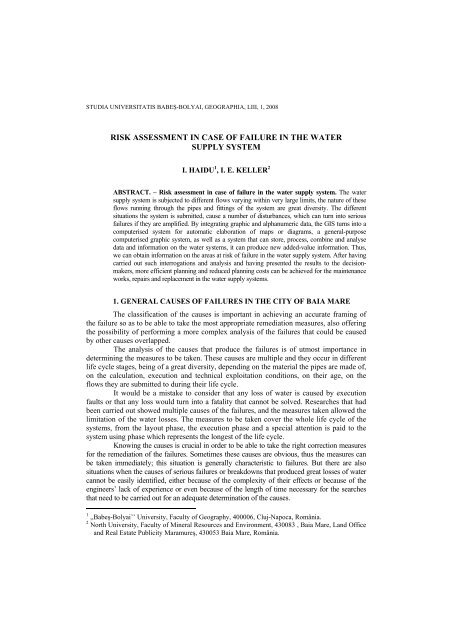studia universitatis babeÅ â bolyai geographia 1
studia universitatis babeÅ â bolyai geographia 1
studia universitatis babeÅ â bolyai geographia 1
Create successful ePaper yourself
Turn your PDF publications into a flip-book with our unique Google optimized e-Paper software.
STUDIA UNIVERSITATIS BABEŞ-BOLYAI, GEOGRAPHIA, LIII, 1, 2008<br />
RISK ASSESSMENT IN CASE OF FAILURE IN THE WATER<br />
SUPPLY SYSTEM<br />
I. HAIDU 1 , I. E. KELLER 2<br />
ABSTRACT. – Risk assessment in case of failure in the water supply system. The water<br />
supply system is subjected to different flows varying within very large limits, the nature of these<br />
flows running through the pipes and fittings of the system are great diversity. The different<br />
situations the system is submitted, cause a number of disturbances, which can turn into serious<br />
failures if they are amplified. By integrating graphic and alphanumeric data, the GIS turns into a<br />
computerised system for automatic elaboration of maps or diagrams, a general-purpose<br />
computerised graphic system, as well as a system that can store, process, combine and analyse<br />
data and information on the water systems, it can produce new added-value information. Thus,<br />
we can obtain information on the areas at risk of failure in the water supply system. After having<br />
carried out such interrogations and analysis and having presented the results to the decisionmakers,<br />
more efficient planning and reduced planning costs can be achieved for the maintenance<br />
works, repairs and replacement in the water supply systems.<br />
1. GENERAL CAUSES OF FAILURES IN THE CITY OF BAIA MARE<br />
The classification of the causes is important in achieving an accurate framing of<br />
the failure so as to be able to take the most appropriate remediation measures, also offering<br />
the possibility of performing a more complex analysis of the failures that could be caused<br />
by other causes overlapped.<br />
The analysis of the causes that produce the failures is of utmost importance in<br />
determining the measures to be taken. These causes are multiple and they occur in different<br />
life cycle stages, being of a great diversity, depending on the material the pipes are made of,<br />
on the calculation, execution and technical exploitation conditions, on their age, on the<br />
flows they are submitted to during their life cycle.<br />
It would be a mistake to consider that any loss of water is caused by execution<br />
faults or that any loss would turn into a fatality that cannot be solved. Researches that had<br />
been carried out showed multiple causes of the failures, and the measures taken allowed the<br />
limitation of the water losses. The measures to be taken cover the whole life cycle of the<br />
systems, from the layout phase, the execution phase and a special attention is paid to the<br />
system using phase which represents the longest of the life cycle.<br />
Knowing the causes is crucial in order to be able to take the right correction measures<br />
for the remediation of the failures. Sometimes these causes are obvious, thus the measures can<br />
be taken immediately; this situation is generally characteristic to failures. But there are also<br />
situations when the causes of serious failures or breakdowns that produced great losses of water<br />
cannot be easily identified, either because of the complexity of their effects or because of the<br />
engineers’ lack of experience or even because of the length of time necessary for the searches<br />
that need to be carried out for an adequate determination of the causes.<br />
1 ,,Babeş-Bolyai’’ University, Faculty of Geography, 400006, Cluj-Napoca, România.<br />
2 North University, Faculty of Mineral Resources and Environment, 430083 , Baia Mare, Land Office<br />
and Real Estate Publicity Maramureş, 430053 Baia Mare, România.
















